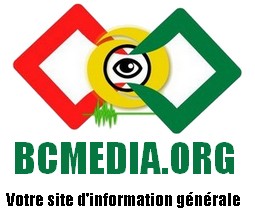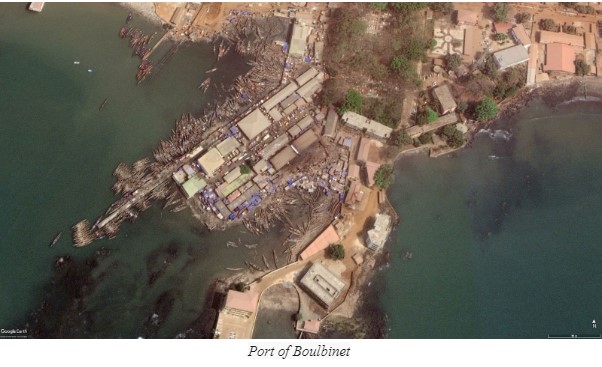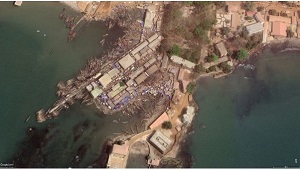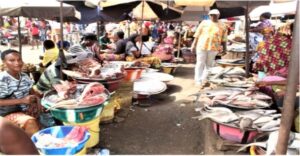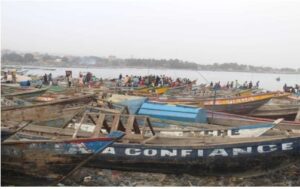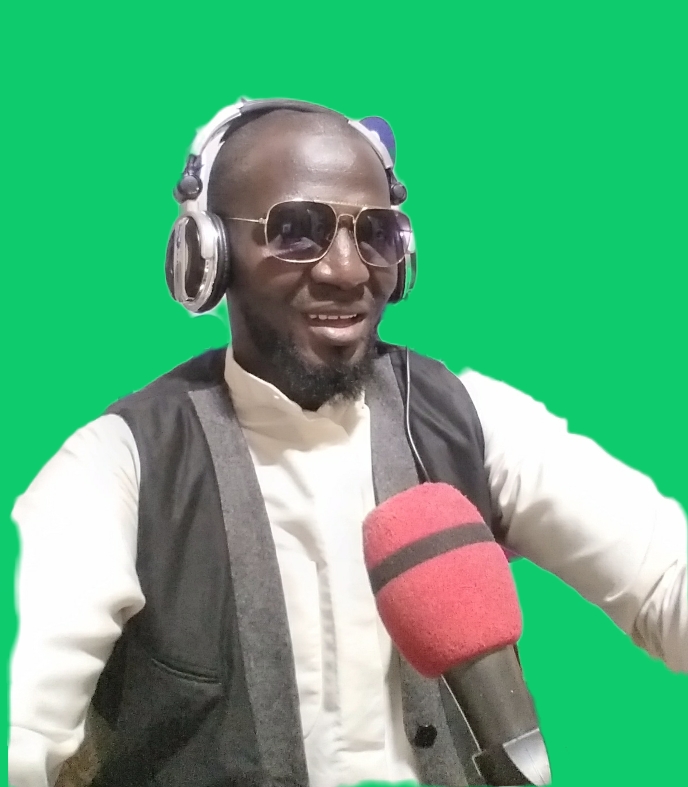By Bah Mohamed
Communities residing along the coast of Guinea rely heavily on fishing, an activity passed down through generations. However, these communities are particularly vulnerable to the detrimental effects of Illegal, Unreported, and Unregulated (IUU) fishing, which we will explore in this investigative piece. We aim to shed light on the extent of this issue and highlight how it mobilises the actors of the fish production chain, along with Guinean authorities, to minimise losses amounting to millions of dollars. The ultimate goal is to enable coastal populations to continue their centuries-old tradition of relying on seafood as a source of livelihood.
Notably, Guineans have a high demand for fish. In this line, Dr. Camara Mohamed Lamine, Director General of the Strategy and Development Office of the Ministry of Fisheries and the Maritime Economy, emphasises the importance of fishing in the country due to the high consumption rate.
Port of Boulbinet
Largest catches of fish and shellfish
IUU fishing is prevalent in Guinea’s over 300 km long coastline and 116,584 km² exclusive economic zone. Notably, over 1.5 million of Guinea’s 11 million inhabitants rely on fish products for their livelihoods. In the past two years, the number of food-insecure people in West Africa and the Gulf of Guinea has doubled, with the issue of IUU fishing complicating the matter. IUU fishing has also emerged as the primary factor causing economic instability in the Gulf of Guinea, according to the Maritime Information Cooperation and Awareness Center. The practice has been cited for exerting pressure on fish stocks and harming local populations. Ramatoulaye Diallo, a journalist and housewife, shared the impact of IUU on the local ecosystem.
« When you go to the market, you might not find certain fish species you want to cook due to illegal fishing practices. These fish are unavailable in the local market and can only be found abroad. So, sometimes you don’t have a choice of what you want to eat simply because it’s not available in the Guinean market because of IUU fishing, » she explained.
Elsewhere, a fisheries biologist at the Center National of the Sciences Fisheries of Boussoura (CNSHB), Amadou Bah, highlighted IUU effects are already evident, especially in the existence of fish species.
« The sawfish and the ray shark have completely disappeared from Guinean waters. These are large pelagic species. Even the bonga fish, a small pelagic, has decreased in size. The size that we were able to catch during the 1990s and 2000s is no longer possible today because the minimum size for sexual maturity is not respected. This size is crucial in determining whether a fish can be caught. If a fish is caught below this size (in relation to its size and weight), it should not be fished, » he explained.
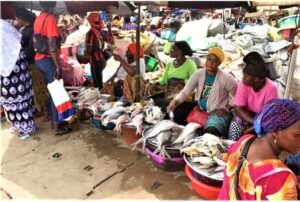
Sale of fish at the Bonfi market
The issues of IUU have also caught the attention of authorities, with the Ministry of Fisheries and Maritime Economy having enforced a 60-day biological rest period in Guinean territorial waters for several years, prohibiting industrial fishing. According to Bah, the rest periods coincide with the spawning phase of certain species, and the government uses biological indicators to make informed decisions. The ministry is also actively deploying resources to enforce the regulations and capture vessels violating laws imposed on the Guinean waters, including boarding foreign vessels in irregular situations. The accelerated efforts have come after Guinea was removed from the list of non-cooperating third countries in the fight against IUU fishing.
“Then the National Vessel Inspection Plan is put in place, securing industrial fishing licenses and revitalising control, monitoring, and surveillance systems. The fisheries governance project aims to consolidate the achievements obtained by strengthening transparency and reviewing regulatory and institutional texts,” said Mohamed Sankhon, former Director General of the Office of Strategy and Development at the Ministry of Fisheries and Maritime Economy.
Annually, the Department of Fisheries and Maritime Economy also conducts a demersal campaign to determine the biomass that needs to be allocated to fishermen. Going beyond this quota established by scientists puts the ecosystem at risk.
“If nothing is done now, it is the disappearance or the rarity of certain species in Guinean waters. If we find them, they will be small. There is a commercial size at first sexual maturity, which allows the species to lay eggs at least once. If we take the female, the young, and the eggs, nothing will remain to perpetuate this generation. Species must be allowed to reproduce at least once because they lay thousands of eggs. If they lay at least once with the commercial size, they can be captured,” Bah warned.
At the same time, professional associations in the fishing sector are concerned about unauthorised foreign vessels fishing in the Guinean marine environment.
“Sometimes, given the scarcity of fish, ships burst into the area reserved for traditional fishing, which scrapes everything in their path, leaving nothing for the locals. We even record collisions of industrial fishing vessels boarding small artisanal fishing boats at sea. Unfortunately, sometimes there are cases of death,” said Fodé Idrissa Kallo, Secretary of External Affairs and Communication of the National Federation of Artisanal Fishermen of Guinea.
The exact losses caused by IUU fishing are difficult to calculate. However, the CSRP (Sub-Regional Fisheries Commission) estimates that nearly $400 million are lost annually by member countries such as Guinea, Mauritania, Cape Verde, Guinea-Bissau, Senegal, and Sierra Leone. The Secretary General of the Ministry of Fisheries and Maritime Economy, Amara Kaba Camara, suggests that a particular country could experience losses of $80 to $100 million.
The evolution of fishery product catches in the Exclusive Economic Zone (EEZ), and the highest annual catches of artisanal and industrial fishery products are also noteworthy.
Furthermore, the Guinean government has recently implemented measures and reforms to improve the legal and regulatory framework, real-time monitoring, and satellite surveillance of fishing activities. In August 2021, a « Strengthening Fisheries Governance in Guinea » project was launched in Conakry, financed by OCEANS 5 and Norwegian Agency for Development Cooperation (Norad). The three-year project aims to reduce IUU fishing practices and overexploitation in Guinean waters. It was developed in partnership with the PRCM, GRID-Arendal, and Trygg Mat Tracking (TMT) and covered seven countries in West Africa. The entities were onboarded to offer technical support.
Consequently, Dr. Kady Sané Diouf, Coordinator of fisheries governance projects in West Africa, has praised the government’s commitment to the efforts to curb IUU. According to Diouf:
“Raising awareness of the impacts of IUU fishing is so that we can give ourselves, and so to fight against this scourge which is truly a devastating phenomenon. IUU fishing leaves no one indifferent. Guinea has not escaped this phenomenon. We have noted that the Guinean government has made a lot of effort for some time. I can cite, for example, the development of the national plan to combat IUU fishing, which is extremely important. Guinea is also very transparent: it is one of the first countries to publish information on fishing through the Ministry of Fisheries website. Due to Guinea’s efforts, donors and environmental conservation NGOs are committed to supporting this initiative. Above all, we will focus on strengthening technical capacities to fight against IUU fishing.”
The project’s coordinator in Guinea, Ismaël Keïta, discussed the expected achievements in the first year. According to Keïta:
“In the first year, this project was carried out through several Ministry of Fisheries and Maritime Economy structures, including the National Centre of Surveillance of the Peaches, the National of the Peaches Maritimes, the National Fisheries Planning, and the National Office for the Sanitary Control of Fishery and Aquaculture Products.”
Yann Yvergniaux, Senior Analyst at Trygg Mat Tracking (TMT), also highlighted the role of technical partners on the project.
“The process aims to support the issuance of fishing licenses to close the door to fishing vessels that engage in criminal activities or fishing companies with a history of engaging in illegal activities. The idea is to build capacity so that inspections can be carried out more thoroughly. That research will be done on the background of the vessels before permitting them to operate in Guinea,” he said
The Ministry of Fisheries and Maritime Economy and its strategic partners PRCM, GRID-Arendal, and TMT also organised a workshop on information and training for journalists from December 27 to 28, 2022, in Conakry. The session aimed to enhance the skills of media personnel in better-covering issues related to fishing in general and the negative impacts of IUU fishing in Guinea.
“The media plays a crucial role in raising awareness about the devastating effects of IUU fishing, which affects almost all African states, including Guinea. To reach a wider audience, we have organised awareness and information workshops on the concept at the community level and for state officials. However, it’s important to involve the media to inform communities about the issue better,” stated Keïta.
Additionally, the government has created measures enabling authorities to monitor marine resources. One such resource is the National Fisheries Surveillance and Police Center (CNSP). The entity has inspectors who use speedboats to patrol the seas and ensure that fishing ships have the necessary papers, follow regulations and use the right equipment. Violating vessels are boarded, sent to the dock, and face penalties. Besides CNSP, the French Navy also coordinates and monitors all the actions of the maritime prefecture, leveraging semaphores and surveillance software to fight IUU fishing.
The Center of Research Fisheries Boussoura studies Guinea’s marine and coastal environments. Its main objective is to generate knowledge of fishing, aquaculture, and the maritime economy. All this information aims to facilitate decision-making processes prioritising the sustainable development of fisheries resources in Guinea. Additionally, the centre guides fish mesh and determines the biomass and the quantity of fish in the water.
“We have a research vessel. Every year, we do two campaigns on demersal resources. West African nations, the entire EEZ (Exclusive Economic Zone, a maritime space over which a coastal State exercises sovereign and economic rights in exploring and using natural resources). We identify all the species, weigh them, we take the measurements. We take some to the laboratory to make the sex ratio, to measure the size at the first reproduction,” said Prof. Alkaly Doumbouya, Director of Research at the National Center for Science Fisheries Boussoura
According to the FAO, aquatic food products contribute a more significant share of animal protein intake in low-income countries.
Number of days at sea in artisanal sea fishing in Guinea
“They are not authorised; they rely on the weakness of our technical means. Even if you see them, you can’t board them immediately,” said Prof. Doumbouya.
Impact on households
The increase in illegal fishing practices along the Guinean coast has significantly affected the activities of wholesalers, ship owners, and heads of families, leading to financial suffering. According to Fodé Idrissa Kallo, Secretary for Affairs and External Communication of the National Federation of Artisanal Fishermen of Guinea, fishermen have experienced diminishing incomes due to IUU fishing for several years. They catch small fish to sell in the local market. Still, the fishmongers cannot cover the expenses, resulting in decreased capital and increased credit, leading to their eventual withdrawal from fishing activities.
Small-scale fishermen also encounter difficulties obtaining fishing authorisation documents due to the high cost. Kallo highlighted this challenge:
“At the level of semi-industrial fishing, there is no problem because the payments are made in bank accounts, but at the level of artisanal fishing, you may encounter problems. You will find at the level of the municipality of Kaloum you are told, for example a ‘’foun founyi’ * at 150,000 Guinean francs. At Dixinn, you ask for aWhether* We give you a » Foun founyi » and we withdraw the price of Boya, which costs between 200,000 and 250,000 Guinean francs. You will always find a price difference in the field depending on the area.”
Fishing in Guinean waters requires various licenses, including artisanal, semi-industrial, and industrial fishing licenses, as well as navigation and driver’s licenses issued by the Agence de Navigation Maritime (ANAM), a department of the Ministry of Transport. The Ministry of Fisheries issues permits for fishing in Guinean waters, including three categories of artisanal fishing: advanced, motorised, and traditional. Nationals and foreigners must pay an annual fee to obtain these permits or other artisanal fishing licenses.
There is also a justification for high fish prices in the fishing sector by pointing out that some actors often claim ignorance of regulations and insufficient popularisation of governing documents for artisanal fishing in Guinea. Kallo stated that professional organisations do not adequately equip or train their members to understand official prices and prevent scams.
Market of Kaporo
Over the last few years, non-governmental organisations (NGOs) have taken advantage of new information and communication technologies to combat illegal fishing and enhance fisheries governance. Yvergniaux describes some of these initiatives, which involve providing information and analysis to stakeholders.
« The interface allows you to access fishing vessel identity data and their previous operations, which are presented simply and intuitively using multiple data sources, » explained Yvergniaux.
He expressed hope that such tools, once in the hands of fishing authorities, will be utilised as part of the license application process. Yvergniaux further emphasised that the case officer can perform background checks on the boat using the data provided by the interface.
Furthermore, under the implementation of port state measures, Guinea can deny foreign-flagged vessels, many of which have allegedly been involved in illegal fishing incidents, as Yvergniaux pointed out.
Port of Bonfi
Guinean authorities are collaborating with partners to enhance transparency and participation in the governance of marine fisheries. The National Surveillance and Police Center (CNSP) has established six coastal bases along the coast and made small speedboats available to personnel for surveillance on the high seas.
A fisheries development and management plan has also been developed in mutual agreement with industrial and artisanal fishing professionals to allow the sea’s resources to reproduce better. This plan also establishes limits on the fishing zone for protected marine species that fishermen must respect.
In an ongoing initiative called participatory surveillance, Guinean authorities are considering training and equipping non-state actors, such as fishermen, in water monitoring with a kit consisting of a telephone and GPS. These actors can then communicate with government agents through operating mechanisms at sea.
Guinea has also joined the Fishery Transparency Initiative (FiTI) to improve the transparency of systems for collecting and sharing information. The FiTI is a global transparency standard that helps coastal countries increase the credibility and quality of national fisheries information.
At the local level, the regional sea and air surveillance campaign in the Gulf of Guinea is combined with small planes flying over the sea to tackle cases of IUU fishing. According to the Guinean authorities, initiatives such as the « Strengthening fisheries governance in Guinea » project, piloted by GRID-Arendal, improve governance.
*The drifting gillnet or founfounyi. This type of gear, which uses a simple technique and its widespread in Guinea. The characteristics are quite homogeneous throughout the coast (mesh: 60–70 mm ; length : 400–600 m ; chute : 6 m).
*The gill net encircling or gboya in the broad sense. This category likely includes the least sliced types of fillets and can be further subdivided into several subtypes. Nevertheless, regardless of the subtype, the fishing technique used to catch these fish is the same. This technique, known as « setting work, » involves spotting the fish, circling them, and creating noise to lure them into the mesh.
This story was supported by Code for Africa (CfA) in partnership with GRID-Arendal as part of the Environmental Journalism fellowship on IUU fishing in Guinea.”
Bah Mohamed
bahmohamedplus@gmail.com
